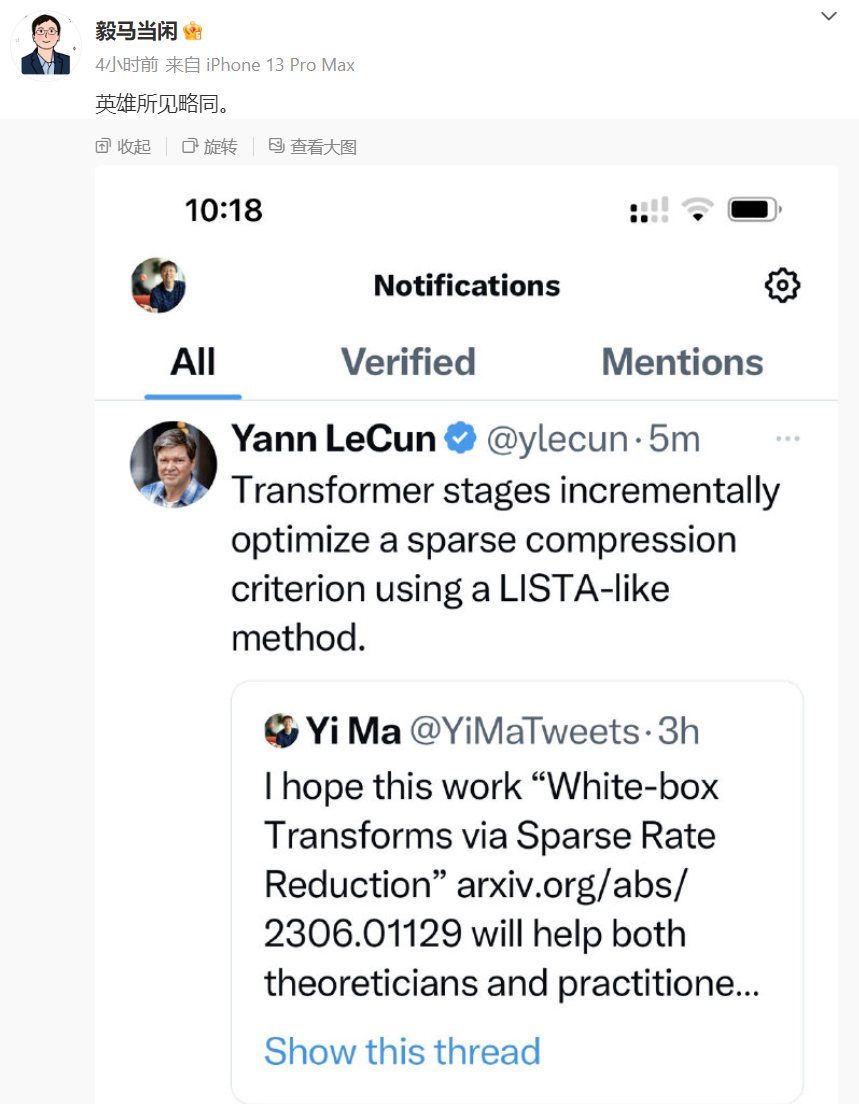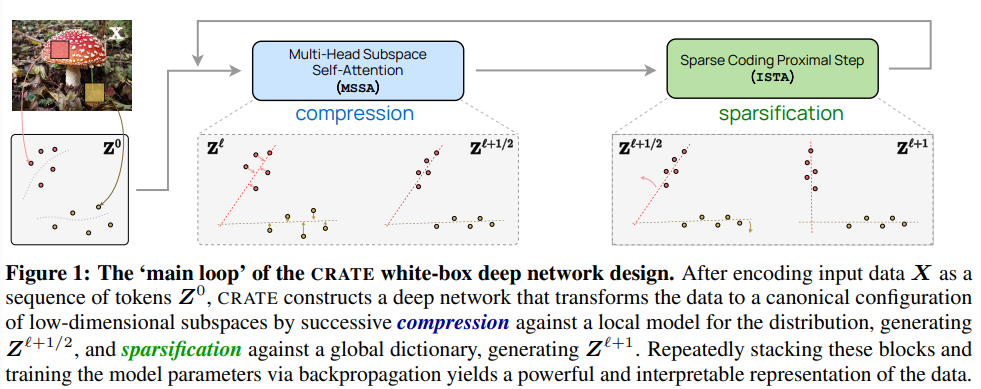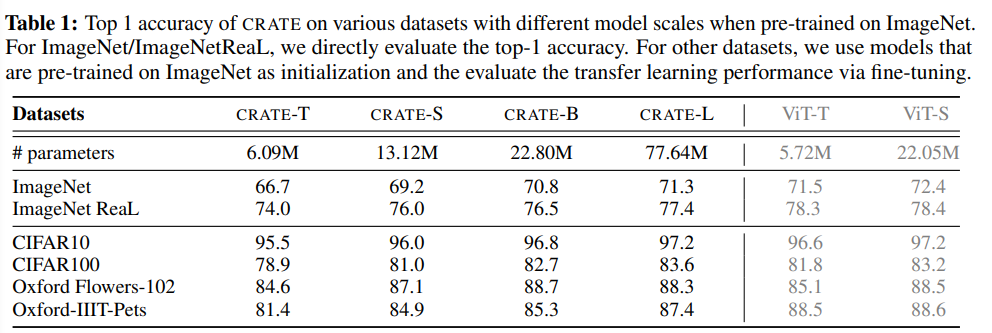 Technology peripherals
Technology peripherals
 AI
AI
 LeCun supports it. Professor Ma Yi's five-year masterpiece: a completely mathematically interpretable white-box Transformer whose performance is not inferior to ViT.
LeCun supports it. Professor Ma Yi's five-year masterpiece: a completely mathematically interpretable white-box Transformer whose performance is not inferior to ViT.
LeCun supports it. Professor Ma Yi's five-year masterpiece: a completely mathematically interpretable white-box Transformer whose performance is not inferior to ViT.
In the past ten years or so, the rapid development of AI has mainly been due to progress in engineering practice. AI theory has not played a role in guiding algorithm development. The empirically designed neural network is still a black box.
With the popularity of ChatGPT, the capabilities of AI have been constantly exaggerated and hyped, even to the point of threatening and kidnapping society. It is urgent to make the Transformer architecture design transparent!

Recently, Professor Ma Yi’s team released the latest research results and designed a white-box Transformer model CRATE that can be completely explained by mathematics. And achieved performance close to ViT on the real-world data set ImageNet-1K.
Code link: https://github.com/Ma-Lab-Berkeley/CRATE
Paper link: https://arxiv.org/abs/2306.01129
In this paper, the researchers believe that the goal of representation learning is to compress and transform data ( For example, the distribution of token set) to support the mixing of low-dimensional Gaussian distributions on incoherent subspaces. The quality of the final representation can be measured by the unified objective function of sparse rate reduction.
From this perspective, popular deep network models such as Transformer can be naturally considered as realizing iterative schemes to gradually optimize this goal.
In particular, the results show that the standard Transformer block can be derived from an alternating optimization of complementary parts of this objective: the multi-head self-attention operator can be viewed as minimizing the The gradient descent step reduces the coding rate to compress the token set, and the subsequent multi-layer perceptron can be thought of as trying to sparse the token representation.
This discovery also prompted the design of a series of white-box Transformer-like deep network architectures that are fully interpretable mathematically. Although simple in design, experimental results show that these networks are indeed Learned to optimize design goals: compress and sparsify representations of large-scale real-world visual datasets such as ImageNet, and achieve performance close to highly engineered Transformer models (ViT).
Turing Award winner Yann LeCun also agreed with Professor Ma Yi’s work and believed that Transformer uses a method similar to LISTA (Learned Iterative Shrinkage and Thresholding Algorithm) to incrementally optimize sparse compression.

Professor Ma Yi received a double bachelor's degree in automation and applied mathematics from Tsinghua University in 1995, and a master's degree in EECS from the University of California, Berkeley in 1997 , received a master's degree in mathematics and a doctorate in EECS in 2000.

#In 2018, Professor Ma Yi joined the Department of Electrical Engineering and Computer Science at the University of California, Berkeley. In January this year, he joined the University of Hong Kong as the Data Science Research Institute. Director, and recently took over as Head of the Department of Computing at the University of Hong Kong.
The main research directions are 3D computer vision, low-dimensional models of high-dimensional data, scalability optimization and machine learning. Recent research topics include large-scale 3D geometric reconstruction and interaction and The relationship between low-dimensional models and deep networks.
Let Transformer become a white box
The main purpose of this paper is to use a more unified framework to design a network structure similar to Transformer, so as to achieve mathematical reliability Interpretable and good practical performance.
To this end, the researchers proposed to learn a sequence of incremental mappings to obtain the minimal compression and sparsest representation of the input data (token set) and optimize a unified The objective function is to reduce the sparsity rate.

This framework unifies "Transformer model and self-attention", "diffusion model and noise reduction", "structured search and rate reduction" (Structure-seeking models and rate reduction) and show that Transformer-like deep network layers can be naturally derived from unrolling iterative optimization schemes to incrementally optimize sparsity rate reduction goals.

Mapped target
Self-Attention via Denoising Tokens Towards Multiple Subspaces
The researchers used an idealized token distribution model to show that if it iterates toward a low-dimensional subspace series Noise, the relevant scoring function will take on an explicit form similar to the self-attention operator in Transformer.
Self-Attention via Compressing Token Sets through Optimizing Rate Reduction
Researchers derived the multi-head self-attention layer is an unfolded gradient descent step to minimize the lossy coding rate portion of the rate reduction, thus demonstrating an alternative way of interpreting self-attention layers as compressed token representations.
MLP via Iterative Shrinkage-Thresholding Algorithms (ISTA) for Sparse Coding
The researchers demonstrated that in the Transformer block The multi-layer perceptron immediately following the multi-head self-attention layer can be interpreted as (and can be replaced by) a layer that gradually optimizes the sparsity rate reduction target remainder by constructing a token representation sparse encoding.
CRATE
Based on the above understanding, the researchers created a new white-box Transformer architecture CRATE (Coding RAte reduction TransformEr) to learn the objective function and deep learning architecture and the final learned representation are fully mathematically interpretable, where each layer performs a step of the alternating minimization algorithm to optimize the sparsity reduction goal.

It can be noticed that CRATE chooses the simplest possible build method at every stage of the build, as long as the newly built parts remain the same The conceptual role can be directly replaced and a new white box architecture obtained.
Experimental Section
The researchers’ experimental goals were not just to compete with other well-designed Transformers using the basic design, but also to:
1. Unlike empirically designed black-box networks that are usually only evaluated on end-to-end performance, white-box designed networks can look inside the deep architecture and verify the layers of the learned network Whether it actually performs its design goal, which is to perform incremental optimization on the target.
2. Although the CRATE architecture is simple, the experimental results should verify the huge potential of this architecture, that is, it can be used on large-scale real-world data sets and tasks Achieve performance that matches highly engineered Transformer models.
Model architecture
By changing the token dimension, number of heads and number of layers, study We created four CRATE models of different sizes, denoted as CRATE-Tiny, CRATE-Small, CRATE-Base, and CRATE-Large
Datasets and Optimizations
This article mainly considers ImageNet-1K as the test platform, and uses the Lion optimizer to train CRATE models with different model sizes.
The transfer learning performance of CRATE was also evaluated: the model trained on ImageNet-1K was used as a pre-training model, and then the model was trained on several commonly used downstream data sets (CIFAR10/100, Oxford Flowers, Oxford-IIT-Pets) to fine-tune CRATE.
#Does CRATE’s layer achieve its design goals?

As the layer index increases, you can see that the CRATE-Small model has both compression and sparsification terms in most cases. Improved, the increase in the sparsity measure of the last layer is due to the additional linear layer used for classification.
The results show that CRATE is very consistent with the original design goal: once it is learned, it basically learns to compress and sparse the representation gradually through its layers.

After measuring the compression and sparsification terms on CRATE models of other sizes and intermediate model checkpoints, it can be found that the experimental results are still very consistent, with Models with more layers tend to optimize goals more effectively, validating previous understandings of the role of each layer.
Performance comparison
By measuring the highest accuracy on ImageNet-1K and the The empirical performance of the proposed network is studied through transfer learning performance on several widely used downstream datasets.

Since the designed architecture utilizes parameter sharing in both the attention block (MSSA) and the MLP block (ISTA), the CRATE-Base model (22.08 million) has a similar number of parameters to ViT-Small (22.05 million).
It can be seen that when the number of model parameters is similar, the network proposed in the article achieves ImageNet-1K and transfer learning performance similar to ViT, but the design of CRATE is simpler, Strong interpretability.
In addition, under the same training hyperparameters, CRATE can continue to expand, that is, continuously improve performance by expanding the scale of the model, while directly expanding the scale of ViT on ImageNet-1K and Does not always lead to consistent performance improvements.
That is to say, the CRATE network, despite its simplicity, can already learn the required compression and sparse representation on large-scale real-world datasets and perform well on various tasks such as classification and transfer learning) to achieve comparable performance to more engineered Transformer networks (such as ViT).
The above is the detailed content of LeCun supports it. Professor Ma Yi's five-year masterpiece: a completely mathematically interpretable white-box Transformer whose performance is not inferior to ViT.. For more information, please follow other related articles on the PHP Chinese website!

Hot AI Tools

Undresser.AI Undress
AI-powered app for creating realistic nude photos

AI Clothes Remover
Online AI tool for removing clothes from photos.

Undress AI Tool
Undress images for free

Clothoff.io
AI clothes remover

AI Hentai Generator
Generate AI Hentai for free.

Hot Article

Hot Tools

Notepad++7.3.1
Easy-to-use and free code editor

SublimeText3 Chinese version
Chinese version, very easy to use

Zend Studio 13.0.1
Powerful PHP integrated development environment

Dreamweaver CS6
Visual web development tools

SublimeText3 Mac version
God-level code editing software (SublimeText3)

Hot Topics
 The world's most powerful open source MoE model is here, with Chinese capabilities comparable to GPT-4, and the price is only nearly one percent of GPT-4-Turbo
May 07, 2024 pm 04:13 PM
The world's most powerful open source MoE model is here, with Chinese capabilities comparable to GPT-4, and the price is only nearly one percent of GPT-4-Turbo
May 07, 2024 pm 04:13 PM
Imagine an artificial intelligence model that not only has the ability to surpass traditional computing, but also achieves more efficient performance at a lower cost. This is not science fiction, DeepSeek-V2[1], the world’s most powerful open source MoE model is here. DeepSeek-V2 is a powerful mixture of experts (MoE) language model with the characteristics of economical training and efficient inference. It consists of 236B parameters, 21B of which are used to activate each marker. Compared with DeepSeek67B, DeepSeek-V2 has stronger performance, while saving 42.5% of training costs, reducing KV cache by 93.3%, and increasing the maximum generation throughput to 5.76 times. DeepSeek is a company exploring general artificial intelligence
 KAN, which replaces MLP, has been extended to convolution by open source projects
Jun 01, 2024 pm 10:03 PM
KAN, which replaces MLP, has been extended to convolution by open source projects
Jun 01, 2024 pm 10:03 PM
Earlier this month, researchers from MIT and other institutions proposed a very promising alternative to MLP - KAN. KAN outperforms MLP in terms of accuracy and interpretability. And it can outperform MLP running with a larger number of parameters with a very small number of parameters. For example, the authors stated that they used KAN to reproduce DeepMind's results with a smaller network and a higher degree of automation. Specifically, DeepMind's MLP has about 300,000 parameters, while KAN only has about 200 parameters. KAN has a strong mathematical foundation like MLP. MLP is based on the universal approximation theorem, while KAN is based on the Kolmogorov-Arnold representation theorem. As shown in the figure below, KAN has
 Hello, electric Atlas! Boston Dynamics robot comes back to life, 180-degree weird moves scare Musk
Apr 18, 2024 pm 07:58 PM
Hello, electric Atlas! Boston Dynamics robot comes back to life, 180-degree weird moves scare Musk
Apr 18, 2024 pm 07:58 PM
Boston Dynamics Atlas officially enters the era of electric robots! Yesterday, the hydraulic Atlas just "tearfully" withdrew from the stage of history. Today, Boston Dynamics announced that the electric Atlas is on the job. It seems that in the field of commercial humanoid robots, Boston Dynamics is determined to compete with Tesla. After the new video was released, it had already been viewed by more than one million people in just ten hours. The old people leave and new roles appear. This is a historical necessity. There is no doubt that this year is the explosive year of humanoid robots. Netizens commented: The advancement of robots has made this year's opening ceremony look like a human, and the degree of freedom is far greater than that of humans. But is this really not a horror movie? At the beginning of the video, Atlas is lying calmly on the ground, seemingly on his back. What follows is jaw-dropping
 AI subverts mathematical research! Fields Medal winner and Chinese-American mathematician led 11 top-ranked papers | Liked by Terence Tao
Apr 09, 2024 am 11:52 AM
AI subverts mathematical research! Fields Medal winner and Chinese-American mathematician led 11 top-ranked papers | Liked by Terence Tao
Apr 09, 2024 am 11:52 AM
AI is indeed changing mathematics. Recently, Tao Zhexuan, who has been paying close attention to this issue, forwarded the latest issue of "Bulletin of the American Mathematical Society" (Bulletin of the American Mathematical Society). Focusing on the topic "Will machines change mathematics?", many mathematicians expressed their opinions. The whole process was full of sparks, hardcore and exciting. The author has a strong lineup, including Fields Medal winner Akshay Venkatesh, Chinese mathematician Zheng Lejun, NYU computer scientist Ernest Davis and many other well-known scholars in the industry. The world of AI has changed dramatically. You know, many of these articles were submitted a year ago.
 Google is ecstatic: JAX performance surpasses Pytorch and TensorFlow! It may become the fastest choice for GPU inference training
Apr 01, 2024 pm 07:46 PM
Google is ecstatic: JAX performance surpasses Pytorch and TensorFlow! It may become the fastest choice for GPU inference training
Apr 01, 2024 pm 07:46 PM
The performance of JAX, promoted by Google, has surpassed that of Pytorch and TensorFlow in recent benchmark tests, ranking first in 7 indicators. And the test was not done on the TPU with the best JAX performance. Although among developers, Pytorch is still more popular than Tensorflow. But in the future, perhaps more large models will be trained and run based on the JAX platform. Models Recently, the Keras team benchmarked three backends (TensorFlow, JAX, PyTorch) with the native PyTorch implementation and Keras2 with TensorFlow. First, they select a set of mainstream
 FisheyeDetNet: the first target detection algorithm based on fisheye camera
Apr 26, 2024 am 11:37 AM
FisheyeDetNet: the first target detection algorithm based on fisheye camera
Apr 26, 2024 am 11:37 AM
Target detection is a relatively mature problem in autonomous driving systems, among which pedestrian detection is one of the earliest algorithms to be deployed. Very comprehensive research has been carried out in most papers. However, distance perception using fisheye cameras for surround view is relatively less studied. Due to large radial distortion, standard bounding box representation is difficult to implement in fisheye cameras. To alleviate the above description, we explore extended bounding box, ellipse, and general polygon designs into polar/angular representations and define an instance segmentation mIOU metric to analyze these representations. The proposed model fisheyeDetNet with polygonal shape outperforms other models and simultaneously achieves 49.5% mAP on the Valeo fisheye camera dataset for autonomous driving
 Tesla robots work in factories, Musk: The degree of freedom of hands will reach 22 this year!
May 06, 2024 pm 04:13 PM
Tesla robots work in factories, Musk: The degree of freedom of hands will reach 22 this year!
May 06, 2024 pm 04:13 PM
The latest video of Tesla's robot Optimus is released, and it can already work in the factory. At normal speed, it sorts batteries (Tesla's 4680 batteries) like this: The official also released what it looks like at 20x speed - on a small "workstation", picking and picking and picking: This time it is released One of the highlights of the video is that Optimus completes this work in the factory, completely autonomously, without human intervention throughout the process. And from the perspective of Optimus, it can also pick up and place the crooked battery, focusing on automatic error correction: Regarding Optimus's hand, NVIDIA scientist Jim Fan gave a high evaluation: Optimus's hand is the world's five-fingered robot. One of the most dexterous. Its hands are not only tactile
 DualBEV: significantly surpassing BEVFormer and BEVDet4D, open the book!
Mar 21, 2024 pm 05:21 PM
DualBEV: significantly surpassing BEVFormer and BEVDet4D, open the book!
Mar 21, 2024 pm 05:21 PM
This paper explores the problem of accurately detecting objects from different viewing angles (such as perspective and bird's-eye view) in autonomous driving, especially how to effectively transform features from perspective (PV) to bird's-eye view (BEV) space. Transformation is implemented via the Visual Transformation (VT) module. Existing methods are broadly divided into two strategies: 2D to 3D and 3D to 2D conversion. 2D-to-3D methods improve dense 2D features by predicting depth probabilities, but the inherent uncertainty of depth predictions, especially in distant regions, may introduce inaccuracies. While 3D to 2D methods usually use 3D queries to sample 2D features and learn the attention weights of the correspondence between 3D and 2D features through a Transformer, which increases the computational and deployment time.





